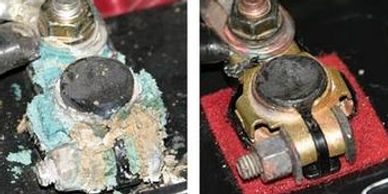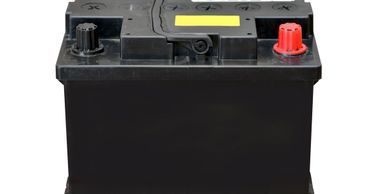Next Service Smart Saturday = January TBD
Car Battery Information Page
GENERAL BATTERY INFORMATION
Types of Batteries We Install
Types of Batteries We Install

According to Cars.com, the average life span of a car battery is around three years.
If yours is getting close to that age, it may be time to have it checked out by a certified professional.
Types of Batteries We Install
Types of Batteries We Install
Types of Batteries We Install

We proudly install World Source One. They come with a two year no questions asked warranty as well as a roadside assistance up to $75!
BATTERY PADS
Types of Batteries We Install

Tired of dealing with corrosion build up on your battery? Our Battery Service is the answer to your battery's prayers! Benefits include extended battery life + terminal corrosion prevention.
THE SCIENCE
Starting & Charging System Testing

Curious about how your car battery works? Want to understand what happens when you recharge your vehicle's battery?
Warning: technical info ahead!
Starting & Charging System Testing
Starting & Charging System Testing
Starting & Charging System Testing
Please note, not all starting problems are directly linked to the battery and sometimes a weak battery is a symptom of another bigger problem.
Quick Glossary
Starting & Charging System Testing
Starting & Charging System Testing

Alternator, battery and starter motor simply defined with common symptoms.
Battery Pad Install Service
Over time corrosion accumulates on the battery posts and terminals. Eventually this build up begins to drain power from the battery. During the Battery Service, a battery cleaner and leak detector is applied after a thorough cleaning and inspection.
Anti-corrosion BG Battery Terminal Protectors are installed and the battery posts, terminals, and case are sealed.
As a preventive measure at PAC, we install these during all new top post battery replacements.
Mission Peace of Mind: Complete
The Science Behind Batteries
Batteries are made up of alternating plates of lead and lead oxide submerged in a bath of sulfuric acid. Each alternating plate is connected so that all the lead oxide plates are connected to each other and all the lead plates are connected to each other.
The lead plates react with the sulfuric acid to create lead sulfate plus free electrons. The free electrons find it easier to travel through the circuits and electrical devices of the vehicle rather than through the sulfuric acid in the battery; their flow powers the devices. After traveling through the wiring, the electrons combine with the lead oxide plates and the sulfate from the acid to create lead sulfate and water.
A completely discharged battery has only lead sulfate plates, and water in place of the sulfuric acid. By charging the battery, the reaction is reversed. Each time the battery is charged and discharged, a small amount of the active material (either lead past or lead dioxide paste) that fills the grids on the plates disintegrates and settles in the bottom of the battery.
When the material is heavily depleted, the amount of power that can be stored in the battery declines. If the disintegrated material reaches the level of plates, that cell of the battery will short circuit, and cease to function, dropping the total available battery voltage even further.

The Starting & Charging System
System Testing
Few things are more frustrating when going out to start your vehicle and it does not turn on or if it does, it seemed to have struggled, leaving you with the worry of becoming stranded somewhere...
The charging system includes the alternator, voltage regulator and connected wiring. The purpose of the alternator is to keep the battery charged while the vehicle is being operated.
The starting system includes components such as the ignition switch, starter motor, battery and connected wiring. The starter motor rotates the engine until it can rotate on its own power.
The alternator is connected to the accessory drive belt system. As the belt turns, it spins the alternator. The alternator produces AC voltage that is converted to DC voltage by the bridge rectifier. A normal output voltage of the alternator is 14.4 volts - enough to charge a 12 volt battery.
When a vehicle is started, current flows from the closed ignition switch to the starter solenoid. Sometimes the park/neutral safety switch is placed in this circuit and will only allow current to the starter if the transmission is placed in Park or Neutral.
Once the starter solenoid is activated, it pushes the starter pinion gear outwards so that it engages with the flywheel ring gear. At the same time, it also allows current to the starter motor, causing the pinion gear to spin. The spinning pinion gear rotates the flywheel until the engine can rotate on its own.
Take the mystery out of this system and give yourself peace of mind by having an ASE Certified Technician inspect the Starting and Charging system. It is important to verify the problem and more importantly the cause of the problem. Before you know it, you could be making a few trips to the auto mechanic without every getting to the source of the problem. Or worse, pay for something and not know what exactly you paid for...
According to Gates (a leading manufacturer of original equipment parts for vehicle manufacturers), there is an epidemic occuring in the industry where batteries, starters, and alternators are being blamed and warrantied when they were perfectly good and the true problem was left unresolved.
Modern vehicles operate as systems
Is the battery discharged because the alternator is not operating correctly because the belt is slipping because the tensioner needs to be replaced?
The picture above is meant to give clients a simplified overview of all the actions your vehicle undergoes when you turn the key (or push the start button). There are other more complex steps not being shown, but you get the idea!
Quick Glossary
Alternator
Starter motor
Alternator

Function: Provides power to the vehicle's electrical system and charges the battery while the engine is running.
Signs of Wear: Engine doesn't turn over, loss of battery power, some loss of electrical power (dimming headlights, etc.), alternator warning light illuminates
Battery
Starter motor
Alternator

Function: Supplies the energy needed to start the engine, provides the current to operate the accessories when the vehicle is not running and protects the Powertrain Control Module (PCM) from high-voltage surges.
Signs of Wear: Lack of power when attempting to start the vehicle or when using the accessories.
Starter motor
Starter motor
Starter motor

Function: The starter motor cranks the engine when engaged with the flywheel. The solenoid uses electromagnetic current to power the start motor and flywheel.
Sings of Wear: Sporadic engine cranking, poor starting qualities.
Professional Auto Care is an auto repair shop located in Southwest Houston. In addition to offering car battery replacement, we can also help with your other starting & charging system testing needs. Trouble starting doesn't always mean the battery needs to be replaced. Our ASE Certified Technicians are trained to follow a process and provide a report with findings of their testing to get to the bottom of your starting problem.
Copyright © 2025 Professional Auto Care - All Rights Reserved.
Privacy Policy is available on the Contact Us Page.
Disclosure: PAC is a participant in the Amazon Services LLC Associates Program, an affiliate advertising program designed to provide a means for sites to earn advertising fees by advertising and linking to Amazon.com.
Hello there!
On our website, you can make reservations (ie. for state inspections, maintenance), find pricing, and learn more about us.
We do NOT provide estimate requests or quotes over the phone.
We will on Christmas Break beginning December 23rd until January 5th.